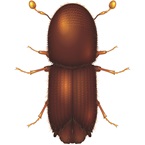Classification:
Species category: Beetles & Weevils
Family: Ptinidae
Description:
1. Ptinus tectus (Australian Spider Beetle)
2. Ptinus fur (White Marked Spider Beetle)
3. Niptus hololeucus (Golden Spider Beetle)
4. Gibbium psylloides (Hump Spider Beetle)
Varying in size by species, these insects are on average 1.7-4mm in length and have a dull-brown/red body with golden hairs. The Hump Spider beetle is different and has a shiny, red-brown to black body with no hairs.
Spider Beetles have 11 segmented antennae and all share a number of spider-like characteristics including a stout body, long legs and generally, a hairy appearance.
Behaviour:
Gregarious and nocturnal, Spider Beetles spend the day in cracks and crevices amongst packaging and the fabric of a building. They thrive in old buildings where they find safe harbourages.
Spider beetle larvae infest all types of dry animal and vegetable matter including grain, spices and fish meal. They will scavenge on debris and bore holes in order to find a safe place to pupate. In doing so, they destroy packaging and contaminate foods.
There are 2-4 generations per year in unheated conditions. All stages except eggs and young larvae can overwinter. Peak activity is reached between August and November.
Region:
The Australian Spider Beetle is Australasian in origin and now is widely distributed. Most spider beetle species are cosmopolitan and are rarely imported.
Habitat:
They enjoy dark and damp conditions and readily feed on moisture-damaged food. Infestations often originate from birds’ nests. Spider beetles are becoming increasingly common in domestic premises where they are found in attics, wall cavities and floorboard cracks.
Granaries and bakeries also offer the perfect conditions and food sources. Hump Spider beetles are tolerant of cool conditions and can survive for long periods without food supplies.
Risks:
Spider beetles can reduce the quality of commodities by contaminating them with webbing and droppings. The larvae bore into packaging and the grain itself, in addition to other materials such as grain sacks, leaving behind tell-tale holes.
Envu recommends using Suspend Flexx Insecticide.

